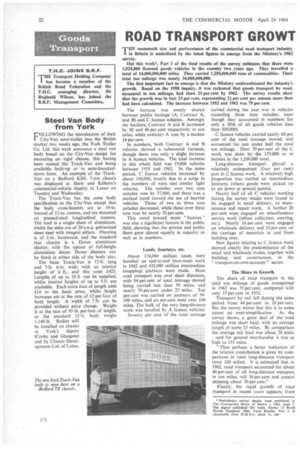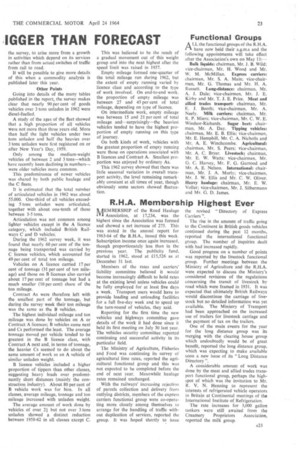ROAD TRANSPORT GROWT 1GGER THAN FORECAST
Page 24

Page 25

If you've noticed an error in this article please click here to report it so we can fix it.
rr HE mammoth size and performance of the commercial road transport industry I in Britain is underlined by the latest figures to emerge from the Ministry's 1962 survey.
Out this week*, Part I of the final results of the survey estimates that there were 1,524,000 licensed goods vehicles in the country two years ago. They travelled a total of 14,000,000,000 miles. They carried 1,250,000,000 tons of commodities. Their total ton mileage was nearly 34,000,000,000.
The first important fact to emerge is that the Ministry underestimated the industry's growth. Based on the 1958 inquiry, it was reckoned that goods transport by road, measured in ton mileage, had risen 23 per cent by 1962. The survey results show that the growth was in fact 33 per cent, representing 21 per cent per annum more than had been calculated. The increase between 1952 and 1962 was 79 per cent.
The increase was evenly shared between public haulage (A, Contract A, and B) and C licence vehicles. Amongst the hauliers, Contract A and B increased by 80 and 46 per cent respectively in ton miles, while ordinary A rose by a modest 18 per cent.
In numbers, both Contract A and B vehicles showed a substantial increase, though there was only a slight increase in A licence vehicles. The total increase in this whole field was 19.000 vehicles between 1958 and 1962. In the same period, C licence vehicles increased by about 180,000, mostly due to a surge in the numbers of vans and similar light vehicles. The number over two tons unladen rose by 37,000, and there was a marked trend toward the use of heavier vehicles. Those of two to three tons unladen decreased, while those over three tons rose by nearly 70 per cent.
This trend toward more "heavies" was also a significant feature in the public field, showing that the private and public fleets grew almost equally in capacity as well as in numbers.
Loads, Journeys, etc.
About 176,000 million loads were handled on end-to-end (non-stop) work in 1962 and 433,000 million intermediate (stopping) journeys were made. Most road transport was over short distances, with 84 per cent of total tonnage moved being carried less than 50 miles, and nearly 70 per cent under 25 miles. Ten per cent was carried on journeys of 50100 miles, and six per cent went over 100 miles. The bulk of the very long-distance work was handled by A licence vehicles.
Seventy per cent of the total tonnage carried during the year was in vehicles exceeding three tons unladen, even though they accounted in numbers for only a fifth of all goods vehicles (less than 300,000).
C licence vehicles carried nearly 60 per cent of the total tonnage moved, and accounted for just under half the total ton mileage. Over 70 per cent of the C work was done by the 179,000 or so heavies in the 1,200,000 total, Long-distance transport played a relatively unimportant (four per cent) part in C licence work. A relatively high proportion was carried on intermediate journeys (where goods were picked up or set down at several points).
Nearly half of all C vehicles working during the survey weeks were found to be engaged in retail delivery, or maintenance and repair work. A further 20 per cent were engaged on miscellaneous service work (refuse collection, catering, etc.). Nearly 16 per cent were engaged on wholesale delivery and 10 per cent on the carriage of materials to and from building sites.
New figures relating to C licence work showed clearly the predominance of the retail and wholesale trades, together with building and construction, in the " transport-on-own-account" sector.
The Share in Growth The share of road transport in the total ton mileage of goods transported in 1962 was 55 per cent, compared with only 37 per cent in 1952.
Transport by rail fell during the same period from 44 per cent to 26 per cent. But the survey warns that this is to some extent an over-simplification. As the survey shows, a great deal of the road mileage was short haul, with an average length of some 25 miles. By comparison the average rail haul was about 70 miles —and for general merchandise it was as high as 135 miles, Thus perhaps a better indication of the relative contribution is given by comparisons in total long-distance transport (over 100 miles). It is estimated that in 1962, road transport accounted for about 40 per cent of all long-distance transport in ton miles, rail 30 per cent and coastal shipping about 30 per cent."
Finally, the rapid growth of road transport in recent years appears, from the survey, to arise more from a growth in activities which depend on its services rather than from actual switches of traffic from rail to road.
It will be possible to give more details of this when a commodity analysis is published later this year.
Other Points Going into details of the many tables published in the report, the survey makes clear that nearly 90 per cent of goods vehicles over 3 tons unladen in 1962 were diesel-fuelled.
A study of the ages of the fleet showed that a high proportion of all vehicles were not more than three years old. More than half the light vehicles under two tons unladen and half the heavies over 3 tons unladen were first registered on or after New Year's Day, 1959.
Only among the medium-weight vehicles of between 2 and 3 tons—which have recently been declining in numbers—, were older vehicles more common.
This predominance of newer vehicles was shared by both public haulage and the C fleets.
It is estimated that the total number of articulated vehicles in 1962 was about 55,000. One-third of all vehicles exceeding 5 tons. unladen were articulated, together with about one-tenth of those between 3-5 tons.
Articulation was not common among lighter vehicles except in the A licence category, which included British Railways C and D vehicles.
During the 1962 survey week, it was found that nearly 60 per cent of the tonnage being transported was carried by C licence vehicles, which accounted for 49 per cent of total ton mileage.
Vehicles on A licence carried 17 per cent of tonnage (31 per cent of ton mileage) and those on B licences also carried about 17 per cent of tonnage but had a much smaller (10 per cent) share of the ton mileage.
Contract As were therefore left with the smallest part of the tonnage, but during the survey week their ton mileage was the same as the B vehicles.
The highest individual mileage and ton mileage was done by vehicles on A or Contract A licences; B vehicles came next and Cs performed the least. The average tonnage moved per vehicle tended to be greatest in the B licence class, with Contract A next and, in terms of tonnage, the heavier Cs seemed to do about the same amount of work as an A vehicle of similar unladen weight.
B licence vehicles included a higher proportion of tippers than other classes, suggesting heavy loads over predominantly short distances (mainly the construction industry). About 80 per cent of • B vehicle work was for hire. In all classes, average mileage, tonnage and ton mileage increased with unladen weight.
The average amount of work done by vehicles of over 21 but not over 3 tons unladen showed a distinct reduction between 1958-62 in all classes except C. This was believed to be the result of a gradual movement out of this weight group and into the next highest after the speed limit was raised in 1957.
Empty mileage formed one-quarter of the total mileage run during 1962, but the extent of empty running varied by licence class and according to the type of work involved. On end-to-end work, the proportion of empty mileage was between 27 and 45 per cent of total mileage, depending on type of licence.
On intermediate work, empty mileage was between 15 and 21 per cent of total mileage and—surprisingly—the heaviest vehicles tended to have the highest proportion of empty running on this type of journey.
On both kinds of work, vehicles with the greatest proportion of empty running were those on operations associated with B licences and Contract A. Smallest proportion was enjoyed by ordinary As.
This 1962 survey showed that there was little seasonal variation in overall transport activity, the level remaining remarkably constant at all times of year, though obviously some sectors showed fluctuation.




















































































































